A place of cultural significance, Obsidian Butte at the Salton Sea once had waves washing the glittering outcropping of volcanic rock and natural glass.
“This is a special place,” says Diné climate journalist Noel Lyn Smith (Navajo), resting her hand on an obsidian boulder. She asks me if it’s somewhere to leave tádídíín (corn pollen). I nod, feeling for the weengushk (sweetgrass) in my pocket.
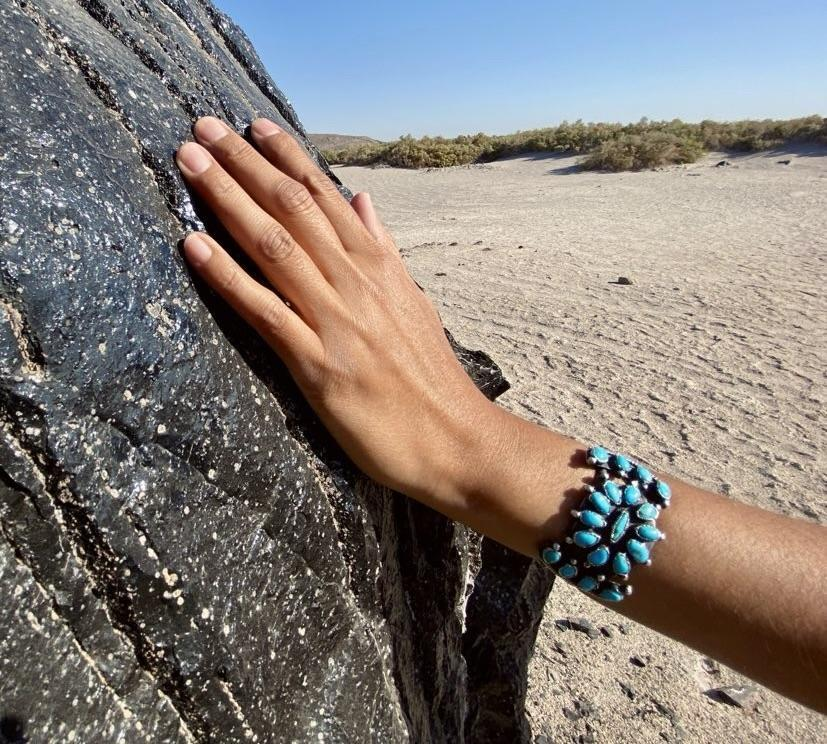
Obsidian Butte, Salton Sea | Photo by Odette Auger
Behind us, a power plant’s steam stacks mark the horizon. It’s one of eleven in a complex of geothermal station sites. Below the surface, lithium created by exploding stars is calling to those who see land as money.
The call for renewable energy and electric vehicles has created a new mining rush to supply “critical minerals,” including lithium. Volcanic activity formed this ridge of obsidian, and brought lithium-bearing magma to the Earth’s crust. The magma cooled and formed rocks, and the weathering of the rocks over time released lithium salts. When water eventually evaporated, lithium-rich brine was left behind.
The California Energy Coalition has stated the Imperial Valley could provide all of the US’ lithium needs, and 40% of the world’s. Controlled Thermal Resources’ Hell’s Kitchen project aims to be the world’s first commercial-scale project to use Direct Lithium Extraction (DLE) technology, which uses solvents to isolate lithium from the geothermal brine as it’s drawn up, instead of the longer process of extracting from large open ponds. The technology, which is untested at commercial scale, poses risks, including air pollution, hazardous waste, and freshwater consumption from an already overburdened Colorado river.
Drying sea, empty nests
Abandoned heron nests mark where the sea’s edge used to be. As the sea evaporates, a crusty playa stretches more than 500 metres before meeting the water, now twice as salty as the ocean. The sea has absorbed agricultural runoff since 1924, including pesticides such as DDT. The polluted waters have seen regular massive die-offs of hundreds of thousands of birds and millions of fish.
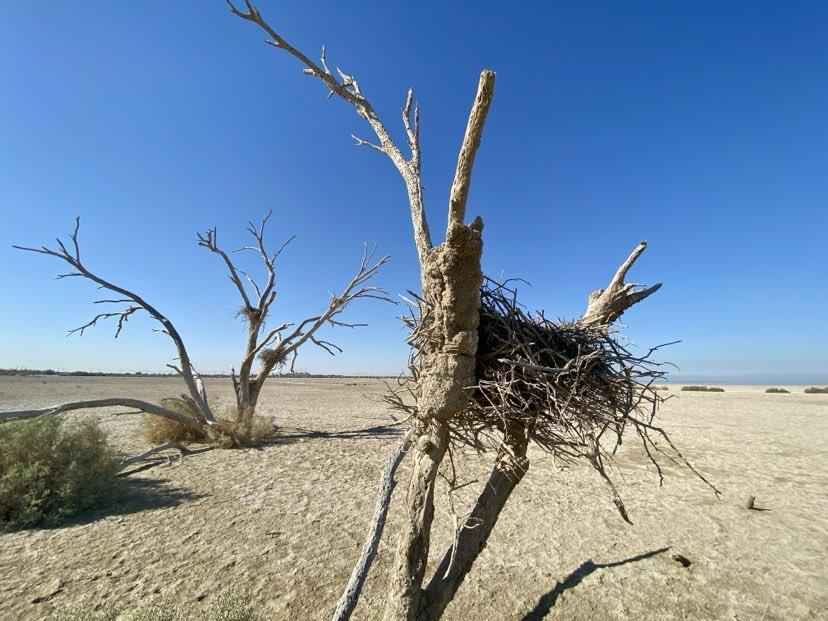
Empty birds nests and dead trees mark where the Salton Sea’s edge used to be. | Photo by Odette Auger
On March 7 2025, Earthworks and the environmental and social justice coalition Comite Civica del Valle (CCV) filed an appeal to the Imperial County Superior Court, following the court’s Feburary 26 dismissal of the groups’ prior legal challenge to the approval of the Hell’s Kitchen project. The community groups argue the county has violated the California Environmental Quality Act by approving the project despite a deeply flawed Environmental Impact Report.
“A just transition to renewable energy requires that we don’t create new sacrifice zones for lithium mining,” said Jared Naimark, California mining organizer for Earthworks. CCV believes the proposed Hell’s Kitchen project should do more to mitigate water usage through stronger water conservation and recycling measures. Their December 2023 appeal requested “more concrete details and teeth to assumptions” about waste such as arsenic, lead, and cadmium before the project begins. “We won’t give up on defending the integrity of those protections. And we won’t let one corporation compromise Imperial Valley’s future.”
Today, members of CCV hand out masks, explaining the exposed seabed releases chemical dust into the air. The air quality index is not good, but acceptable for most. Once AQI hits 101, those with sensitivities are at risk to be outdoors – and 24% of the children in the Imperial Valley have asthma, triple the national average.
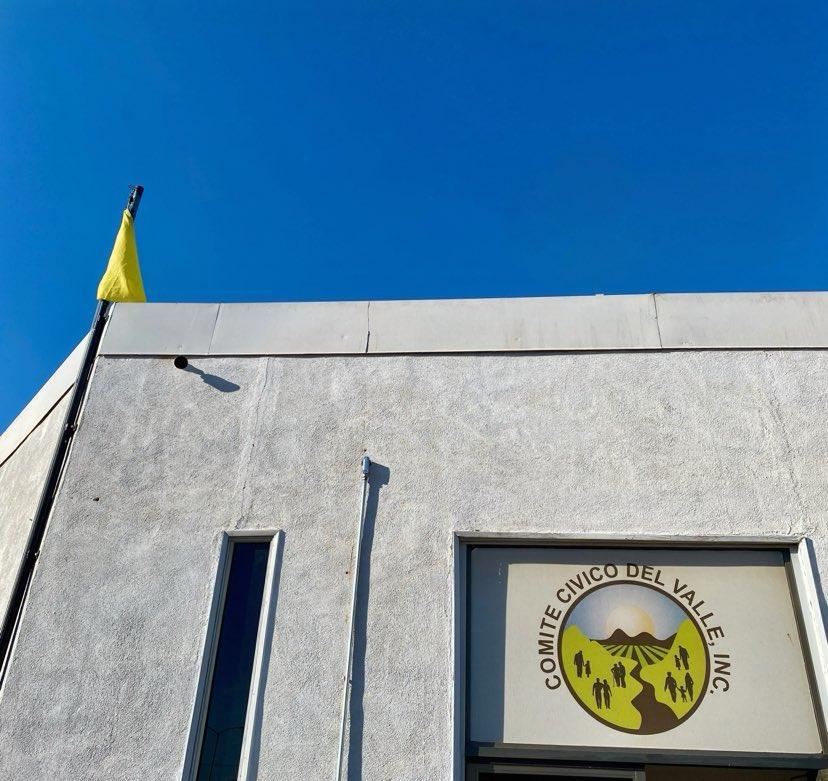
Comite Civico Del Valle coordinates the Air Quality Index flag system – colours range from green to purple. Yellow indicates AQI might not be safe for sensitive people. When it’s red, all children stay indoors. Photo by Odette Auger
Another air quality risk posed by the receding waters is that more geothermal power plants may be developed as the sea shrinks and more dry land becomes available. Of the 12 geothermal drilling sites in the area, only one was closed-loop, and it’s now abandoned. “Open-loop systems expel waste steam and gases into the atmosphere and generally result in greater environmental impacts than closed-loop systems,” says the US Fish and Wildlife Service. (“Closed-loop” means the brine is extracted, processed, and then injected back underground.)
As of late 2023, only one of the three lithium extraction projects at various stages of development near the Salton Sea had completed an Environmental Impact Report. EnergySource Minerals’ EIR can be used as an example to better understand these projects’ potential impacts to air quality. The company plans to inject hydrochloric acid (HCl) into the brine as part of the mineral extraction, creating HCl aerosols, which can cause a range of health impacts, including difficulty breathing. EnergySource Minerals estimates their project will release 7,440 pounds per year of these aerosols, below the 10,000 pounds per year regulation – meaning they won’t be required to mitigate emissions, and they will be allowed to add thousands of pounds of hazardous emissions into already degraded air.
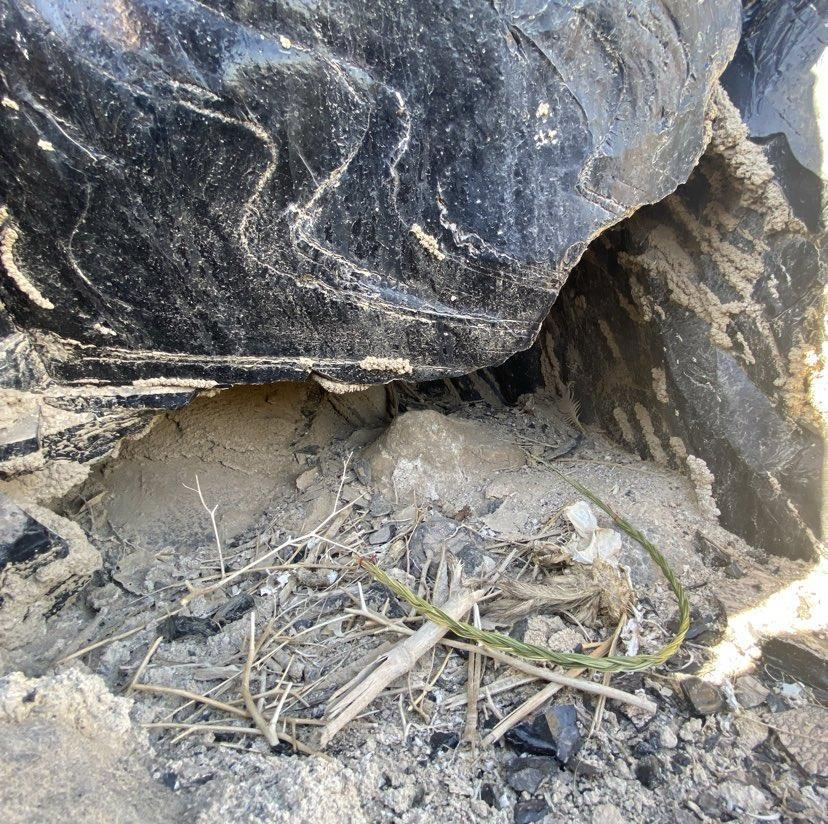
Leaving sweetgrass in nest filled with bird bones | Photo by Odette Auger
Community voices
This place is a cutting example of the hubris of humans, from our attempts to control rivers to the selling and transferring of water rights during drought and climate change. I look to the wall of obsidian for shade from the noon sun, but find it hard to sit still. I’m not the first to find this sheltered bevel to the rock – nooks are filled with many large nests. I lean over, and see the nests are filled with birds’ bones. Tears won’t ever communicate this ache, but some seep out. The Cahuilla creation story of this place tells of the Creator’s tears forming the waters. I place weengushk into the nest, for the birds who still need this place.
Some community voices, including town councils and realtors, are keen to see the economic benefits of lithium mining. EnergySource Minerals claims it will be hiring local, and that’s attractive to an area with 17.9% unemployment in 2024.
I lean over, and see the nests are filled with birds’ bones. Tears won’t ever communicate this ache.
Bari Bean is the Deputy CEO (County Executive Officer), Natural Resources for southern California’s Imperial County. Her title also includes “Lithium Ombudsman” and she was previously marketing manager for BHE, a company that owns 10 geothermal power plants in Imperial Valley. Bean explains they’ve received $800,000 in state funding for “engagement funds,” $80,000 of which was allocated to tribal engagement. “It’s intended to be for government-to-government consultation pertaining to our specific plan and our environmental impact report,” says Bean. “But it can be used in a lot of different ways.” She gives examples of travel, workshops and consulting fees, and marketing materials.
She says 8,000 acres have been earmarked for conservation, with culturally significant sites noted. “Obsidian Butte is one of them But there’s more than one. There’s a lot of different areas that have been identified within that region.”
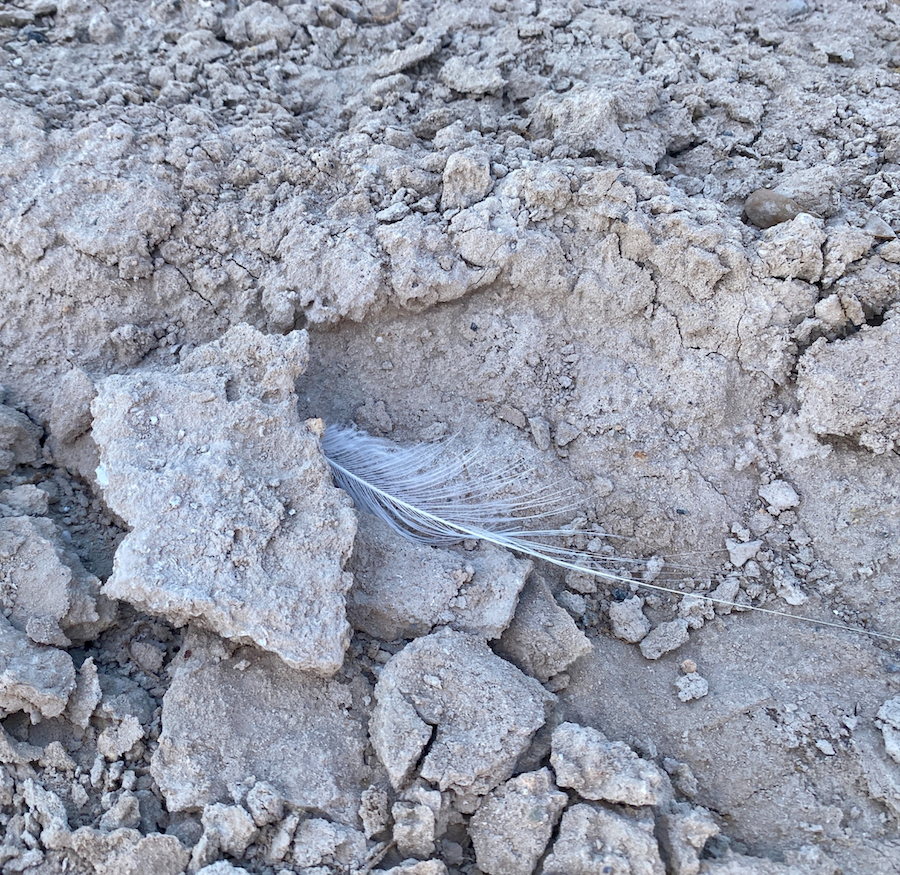
The Salton Sea is an ancestral migration route for many birds. | Photo by Odette Auger
Has the company considered including in the community benefits and protections agreements mitigation of the violence against women and girls that follows these types of industries? Colwell declined to respond.
Silence fills the room, and it becomes apparent that nothing proactive is being considered by company or county. District 4 Supervisor Ryan Kelley speaks up as supervisor of the towns at the epicentre of this extractive industry. Unlike his colleagues, he doesn’t deflect the concern. “Your question is something that we do know, and are concerned about,” he says. He’s been visiting sites in Texas hoping to learn how to avoid the issues “man camps” can bring, including “spontaneous camping locations” and doesn’t want to see that happen in their county. “We are initiating things that will not let that happen here.” He says the conversation is happening, but adds, “Actually there’s nothing written to it.”
In the Imperial Valley, drilling sites are not out in a rural area. The look of mass workers’ housing is different, often based in hotels, within low-income communities of colour.
The Northwest program director at Earthworks, Bonnie Gestring, says their advocacy “highlights the epidemic of violence and other social ills associated with extraction” in the flood of new mining projects across southwestern US. Through letters to Congress, solidarity marches and community workshops, Earthworks fights to bring attention to this “often ignored issue,” she says. “These man camps are temporary, but the trauma from sexual violence can last for generations.”
As a border community, an anonymous community member explained, the presence of cartel-trafficked drugs and sex means tracking violence relating to man camps would be harder to isolate statistically – if anyone was tracking.
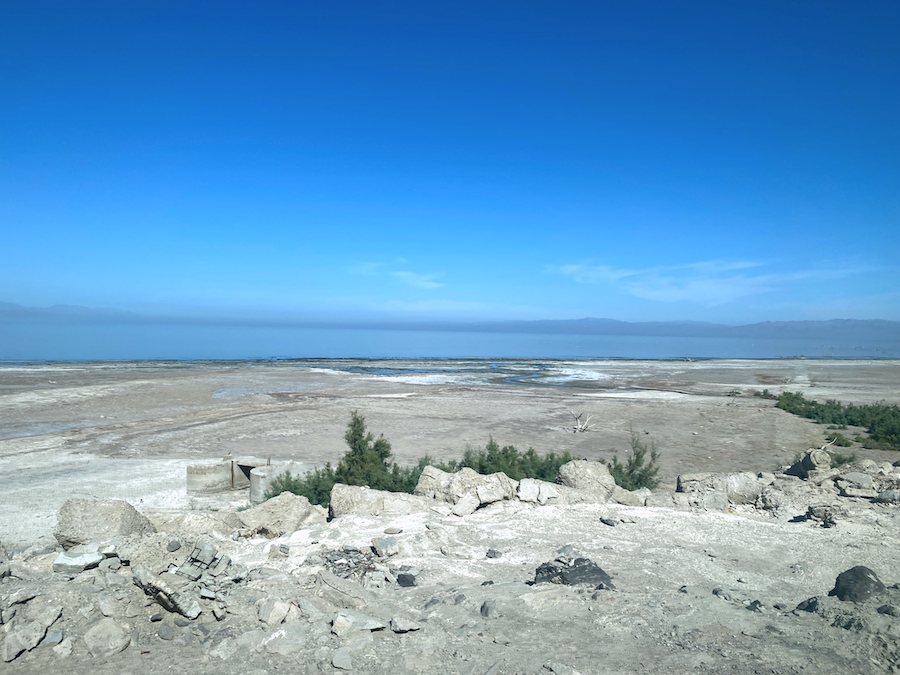
Receding edge of the Salton Sea | Photo by Odette Auger
Gestring explains mining laws and regulations don’t address this critical issue, but “clearly something must be done. Permitting agencies must take a hard look at the impacts of increased violence on women and communities when analyzing proposed projects.” Better laws and regulations are needed to provide Indigenous Peoples and frontline communities with greater influence over mine decisions that impact them, she explains, and “that includes mechanisms related to man camp or temporary workforce siting, management and enforcement.”
Poisoned plants
Among the crystal sharp bluffs, plants delineate where the sea once met land. I notice one tall shrub’s leaves look like oversized sea asparagus. I pinch off the tiniest tip – exactly the same taste and crunch, Salicornia. The women of the CCV look askance – it’s toxic, they explain. Sorrow tightens my throat when I realize if it was a traditional food, it’s not edible now.
White pelicans float at the receding water’s edge, as the sea is a major site on the Pacific Flyway – an ancestral migration route and wintering place for many birds, including federally endangered species.
I think of the birds sensing danger, but having nowhere else to land.
This story is the second in a series on critical minerals mining projects on Indigenous lands the southern United States. It was published with support from the Institute for Journalism & Natural Resources, with Odette Auger receiving a fellowship in their Critical Minerals Institute. See also the first article in this series, “Voices of Chi’chil Biłdagoteel – Where Deep Truth is Spoken.”
Odette Auger (Sagamok Anishnawbek) is an award-winning independent journalist and storyteller living on Klahoose territory in the Salish Sea. Follow her work at authory.com/OdetteAuger.




